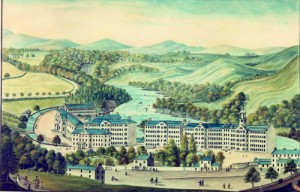Robert Owen and his ‘Village Scheme’
Published in
Features,
Issue 3 (May/June 2014),
Volume 22

At a public meeting in the Rotunda on 12 April 1823, Robert Owen produced a large painting, possibly of New Lanark, which ‘excited general admiration’. Was it this c. 1818 watercolour by John Winning of the mills and village of New Lanark, one of a series commissioned by Owen?
Robert Owen, having made a fortune as a mill manager in Manchester and from 1800 at New Lanark in Scotland, instituted workplace and community reforms, the basis for a wider social agenda. In 1812 he started work on his essays on A new view of society, designed to promote popular but secular education and to overcome poverty, an anathema given the riches created by the Industrial Revolution. The essays, published in one volume in 1816, made Owen famous and he became increasingly more ambitious in his plans for social and economic regeneration. By 1817 he was talking up his ‘Village Scheme’, a plan for self-sustaining communities similar in size to New Lanark, designed to relieve unemployment and poverty. He initiated a lavishly funded propaganda campaign to raise support for a trial of his scheme and in 1822 carried the lessons of New Lanark to Ireland, where famine conditions prevailed in many places.

















